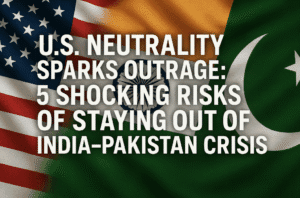U.S. Neutrality Sparks Outrage: 5 Shocking Risks of Staying Out of India-Pakistan Crisis
Amid rising hostilities following a deadly terrorist attack in Kashmir and India’s retaliatory strikes, the U.S. has urged de-escalation while asserting neutrality, with Vice President J.D. Vance declaring the conflict “none of our business.” Washington’s stance emphasizes diplomatic outreach over direct intervention, as Secretary of State Marco Rubio pressed Pakistan to curb terror ties and encouraged dialogue with India. The crisis underscores fears of nuclear escalation, given both nations’ arsenals, though U.S. officials express cautious optimism about regional restraint.
Critics argue America’s hands-off approach risks emboldening aggressors, while supporters view it as pragmatic non-interference. India’s military response and Pakistan’s counteractions highlight unresolved territorial and security grievances, testing Washington’s balancing act between strategic allyship and global crisis management. As global powers monitor the volatility, the situation raises urgent questions about shared responsibility in an era where regional conflicts carry worldwide consequences.

U.S. Neutrality Sparks Outrage: 5 Shocking Risks of Staying Out of India-Pakistan Crisis
Amid escalating hostilities between India and Pakistan following a devastating terrorist attack in Pahalgam and India’s retaliatory military strikes, the U.S. has adopted a policy of cautious neutrality, emphasizing de-escalation while refusing direct intervention. Vice President J.D. Vance’s recent remarks—“We’re not going to get involved in a war that’s fundamentally none of our business”—highlight a strategic pivot toward restraint, raising questions about America’s role in managing crises between nuclear-armed states.
The Catalyst: Terrorism, Retaliation, and a Delicate Diplomatic Dance
The April 22 terrorist attack in Jammu and Kashmir, which claimed 26 lives, including foreign tourists, marked a turning point. India’s subsequent Operation Sindoor targeted alleged terror infrastructure in Pakistan-administered territories, prompting retaliatory strikes and fears of a full-scale conflict. Against this backdrop, Vance’s visit to India—cut short by the crisis—underscored the delicate balance of maintaining alliances while avoiding entanglement.
Washington’s Calculated Neutrality
The U.S. stance, articulated by both Vance and Secretary of State Marco Rubio, prioritizes diplomacy over direct mediation:
- De-escalation Over Intervention: While expressing solidarity with India over terrorism, the U.S. has stopped short of endorsing military actions, instead urging “cooler heads” to prevail.
- Historical Precedent: This approach echoes past U.S. strategies, such as during the 1999 Kargil War, when pressure on Pakistan to withdraw covert forces helped avert broader conflict. However, today’s dynamics are complicated by China’s growing influence in South Asia and India’s strategic importance as a counterweight.
- Nuclear Deterrence Concerns: With both nations possessing nuclear arsenals, Vance acknowledged the “disastrous” risks of escalation but expressed confidence in regional actors’ ability to avoid catastrophe—a stance critics argue underestimates the volatility of the situation.
Diplomatic Tightrope: Rubio’s Dual Outreach
Secretary Rubio’s separate calls to Indian External Affairs Minister S. Jaishankar and Pakistani PM Shehbaz Sharif revealed nuanced diplomacy:
- To India: Reiterated support for counterterrorism efforts while subtly advocating restraint.
- To Pakistan: Pressured Islamabad to “end support for terrorist groups,” a nod to long-standing U.S. frustrations over Pakistan’s alleged ties to militant networks.
This dual-track approach aims to preserve relationships with both nations but risks appearing noncommittal. As former diplomat Richard Haass noted, “Neutrality can signal prudence—or abdication of leadership, depending on the outcome.”
Implications of U.S. Restraint
- India’s Strategic Calculus: New Delhi, which has deepened defense ties with the U.S. in recent years, may perceive limited backing as a diplomatic slight, potentially driving it closer to alternative partners like Russia or France.
- Pakistan’s Dilemma: U.S. demands to curb terrorism without offering concessions could strain already fraught relations, pushing Islamabad toward China or Saudi Arabia for support.
- Global Security Gaps: The U.N. and European powers have echoed calls for de-escalation, but the absence of a unified international mediator heightens risks of miscalculation.
Expert Insights: A Dangerous Precedent?
Security analysts warn that Washington’s hands-off approach may embolden aggressors in future conflicts. “Great powers have a responsibility to prevent nuclear brinkmanship,” said Brookings scholar Tanvi Madan. “Neutrality isn’t a strategy—it’s a gamble.” Others argue that overinvolvement could exacerbate tensions, citing the U.S.’s contentious history in Afghanistan and Iraq.
The Path Ahead
While immediate conflict seems contained, underlying issues—territorial disputes, cross-border terrorism, and nationalist rhetoric—remain unresolved. The U.S. faces a critical test: Can it leverage behind-the-scenes diplomacy to foster dialogue without alienating key allies? For now, Vance’s mantra—“Fundamentally, this is their business”—reflects a broader shift toward pragmatic non-intervention. Yet in an interconnected world, the fallout of South Asian instability is anything but contained.
You must be logged in to post a comment.